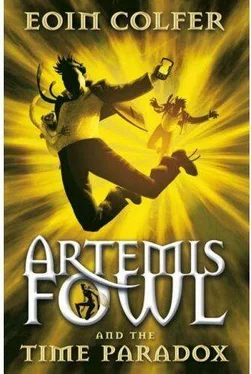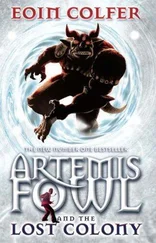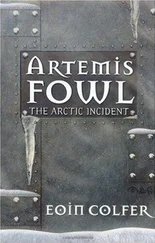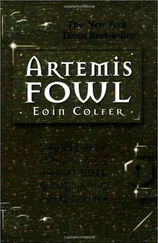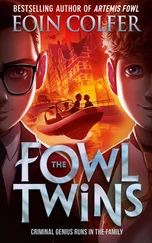Eoin Colfer - Artemis Fowl - the time paradox
Здесь есть возможность читать онлайн «Eoin Colfer - Artemis Fowl - the time paradox» весь текст электронной книги совершенно бесплатно (целиком полную версию без сокращений). В некоторых случаях можно слушать аудио, скачать через торрент в формате fb2 и присутствует краткое содержание. Год выпуска: 2008, Жанр: Фэнтези, на английском языке. Описание произведения, (предисловие) а так же отзывы посетителей доступны на портале библиотеки ЛибКат.
- Название:Artemis Fowl: the time paradox
- Автор:
- Жанр:
- Год:2008
- ISBN:нет данных
- Рейтинг книги:4 / 5. Голосов: 1
-
Избранное:Добавить в избранное
- Отзывы:
-
Ваша оценка:
- 80
- 1
- 2
- 3
- 4
- 5
Artemis Fowl: the time paradox: краткое содержание, описание и аннотация
Предлагаем к чтению аннотацию, описание, краткое содержание или предисловие (зависит от того, что написал сам автор книги «Artemis Fowl: the time paradox»). Если вы не нашли необходимую информацию о книге — напишите в комментариях, мы постараемся отыскать её.
Artemis Fowl: the time paradox — читать онлайн бесплатно полную книгу (весь текст) целиком
Ниже представлен текст книги, разбитый по страницам. Система сохранения места последней прочитанной страницы, позволяет с удобством читать онлайн бесплатно книгу «Artemis Fowl: the time paradox», без необходимости каждый раз заново искать на чём Вы остановились. Поставьте закладку, и сможете в любой момент перейти на страницу, на которой закончили чтение.
Интервал:
Закладка:
‘Are you suggesting that I occasionally stray from the rule book?’ said Holly, apparently horrified by the very notion.
Foaly sniggered. ‘I am suggesting that you may not own a copy of the rule book, and, if you do possess one, you certainly have never opened it.’
Fair point, thought Holly, swooping down towards the surface of Uunisaari.
Whales are thought to be the world’s largest mammals. They are not. The kraken can stretch to five kilometres in length and have been a staple of Scandinavian legend since the thirteenth century, when they appeared in the Orvar Odd saga as the fearsome lyngbakr. Early descriptions of the kraken are the most accurate, describing the sea creature as an animal the size of a floating island whose real danger to ships was not the creature itself, but the whirlpool it created when it sank into the ocean. But by the Middle Ages the legend of the kraken had been confused with that of the giant squid, and each was credited with the most fearsome attributes of the other. The squid was pictured big as a mountain, while the peaceful kraken grew tentacles and developed a bloodlust to rival that of the deadliest shark.
Nothing could be further from the truth. The kraken is a docile creature whose main defences are its sheer size and the bulk of shell, gas and fat cells enclosing a melon-sized brain which provides it with just enough intelligence to feed itself and shed its shell. Underneath the crust of rock, weed and coral, the kraken resembles nothing more than the common acorn barnacle, albeit a barnacle that could easily house an Olympic stadium or two.
The kraken enjoy a lifespan of several thousand years, thanks to an incredibly slow metabolism and a huge network of support systems surrounding their soft centres. They tend to settle in a food-rich or magical environment and remain there until the food or energy residue runs out. Nestling in the middle of an archipelago near a human port provides not only camouflage but an abundant source of edible material. And so this is where the kraken are found, anchored to the seabed like gigantic limpets, vacuuming city waste through their gills and fermenting it to methane in their vast stomachs. But, if human garbage is their salvation, it is also their damnation, for increasingly high toxin levels have rendered the kraken sterile, and now there are only half a dozen or so of the ancient creatures left in the oceans.
This particular kraken was the oldest of the bunch. According to shell scrapings, old Shelly, as the small, dedicated Kraken Watch referred to it, was over ten thousand years old, and had been masquerading as an island in Helsinki harbour since the sixteenth century, when the town was known as Helsingfors.
In all that time, Shelly had done little but feed and sleep, feeling no urge to migrate. Any need he may have felt to move on was dulled by the seepings of a paint factory built on his back more than a hundred years previously. To all intents and purposes, Shelly was catatonic, having emitted no more than a couple of methane flashes in over fifty years, so there was no reason to believe that this red light on his sensor was anything more than a crossed wire, and it was Holly’s job to uncross it. It was a standard first day back on the job kind of mission. No danger, no deadline and little chance of discovery.
Holly turned her palms into the wind, descending till her boots scraped the roof of the island’s small restaurant. Actually, there were two islands, separated by a small bridge. One was a genuine island, and the other, larger section was Shelly nestled into the rock. Holly ran a quick thermal sweep, finding nothing but a few rodents and a blotch of heat from the sauna, which was probably on a timer.
She consulted her visor for the sensor’s exact location. It was four metres underwater, tucked below a rocky ledge.
Underwater. Of course.
She stowed her wings mid-air, then plunged feet first into the Baltic Sea, corkscrewing to minimize the splash. Not that there were any humans close enough to hear. The sauna and restaurant did not open until eight, and the nearest fishermen were on the mainland, their rods swaying gently like rows of bare flagpoles.
Holly vented the gas bags in her helmet to reduce buoyancy and sank below the waves. Her visor informed her that the water temperature was a little over ten degrees, but the shimmer suit insulated her from cold shock and even flexed to compensate for the slight pressure increase.
‘Use the Critters,’ said Foaly, his voice crystal clear through the vibration nodes over her ears.
‘Get out of my head, centaur.’
‘Go on. Use the Critters.’
‘I don’t need a tracer. It’s right there.’
Foaly sighed. ‘Then they shall die unfulfilled.’
The Coded Radiation Tracers were micro-organisms bathed in radiation of the same frequency as the object being located. If you knew what you were looking for before leaving Foaly’s workshop, then the Critters would bring you right to it. Though they were a little redundant when the sensor was a few metres away and beeping on your screen.
‘OK,’ moaned Holly. ‘I wish you would stop using me as a guinea pig.’
She pulled back a watertight flap on her glove, releasing a cloud of glowing orange mites into the water. They bunched for a moment, then sped off in a ragged arrow towards the sensor.
‘They swim, they fly, they burrow,’ said Foaly, awed by his own achievement. ‘God bless their tiny hearts.’
The Critters left a glowing orange wake for Holly to follow. She pulled herself below a sharp ledge to find the Critters already excavating the growths covering the sensor.
‘Now, come on. That is handy. Tell me that’s not useful to a field officer.’
It was very useful, especially since Holly only had ten minutes of air left, but Foaly’s head was big enough as it was.
‘A gill helmet would have been more useful, especially since you knew the sensor was underwater.’
‘You have more than enough air,’ argued Foaly. ‘Especially since the Critters are clearing the surrounding area.’
The Critters ate away the rock and moss covering the sensor until it gleamed like the day it had come off the assembly line. Once their mission was completed, the Critters flickered and died, dissolving in the water with a gentle fizz. Holly switched on her helmet lights, focusing both beams on the alloy instrument. The sensor was the size and shape of a banana and covered with an electrolytic gel.
‘The water is pretty clean, thanks to Shelly. I’m getting a decent picture.’
Holly topped up her suit buoyancy a few notches until she was at neutral, and hung in the water as still as she could.
‘Well, what do you see?’
‘The same as you,’ replied the centaur. ‘A sensor with a flashing red light. I need to take a few readings, if you wouldn’t mind touching the screen.’
Holly laid her palm on the gel so that the omni-sensor on her glove could sync with the ancient instrument.
‘Nine and a half minutes, Foaly, don’t forget.’
‘Please,’ snickered the centaur. ‘I could recalibrate a fleet of satellites in nine and a half minutes.’
It was probably true, thought Holly as her helmet ran a systems check on the sensor.
‘Hmm,’ sighed Foaly, thirty seconds later.
‘Hmm?’ repeated Holly nervously. ‘Don’t hmm, Foaly. Dazzle me with science, but don’t hmm.’
‘There doesn’t seem to be anything wrong with this sensor. It is remarkably functional. Which means …’
‘That the other three sensors are malfunctioning,’ concluded Holly. ‘So much for your genius.’
‘I did not design these sensors,’ said Foaly, wounded. ‘They’re old Koboi gear.’
Читать дальшеИнтервал:
Закладка:
Похожие книги на «Artemis Fowl: the time paradox»
Представляем Вашему вниманию похожие книги на «Artemis Fowl: the time paradox» списком для выбора. Мы отобрали схожую по названию и смыслу литературу в надежде предоставить читателям больше вариантов отыскать новые, интересные, ещё непрочитанные произведения.
Обсуждение, отзывы о книге «Artemis Fowl: the time paradox» и просто собственные мнения читателей. Оставьте ваши комментарии, напишите, что Вы думаете о произведении, его смысле или главных героях. Укажите что конкретно понравилось, а что нет, и почему Вы так считаете.
